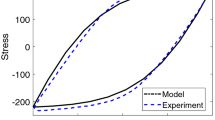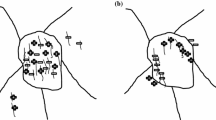Abstract
An axisymmetric cell model analysis is used to study creep failure by grain boundary cavitation at facets normal to the maximum principal tensile stress, taking into account the influence of cavitation and sliding at adjacent inclined grain boundaries. It is found that the interaction between the failure processes on these two types of adjacent facets reduces the failure time significantly when cavitation is creep constrained. In all cases the time to cavity coalescence on transverse facets appears to be a useful lower bound measure of the material life-time. Sliding at the boundaries of the central grain of the cell model is accurately represented; but in some computations a stress enhancement factor is used to incorporate also the effect of sliding between surrounding grains. The influence of grain boundary viscosity is included in the model and it is found that even in the absence of sliding, cavitation on inclined boundaries may significantly reduce the failure time.
Similar content being viewed by others
References
D. Hull and D.E. Rimmer, Philosophical Magazine 4 (1959) 673–687.
A.C.F. Cocks and M.F. Ashby, Progress in Materials Science 27 (1982) 189–244.
A.S. Argon, in Recent Advances in Creep and Fracture of Engineering Materials and Structures, B. Wilshire and D.R.J. Owen (eds.), Pineridge Press, U.K. (1982) 1–52.
A. Needleman and J.R. Rice, Acta Metallurgica 28 (1980) 1315–1332.
T.-L. Sham and A. Needleman, Acta Metallurgica 31 (1983) 919–926.
B.F. Dyson, Metal Science 10 (1976) 349–353.
J.R. Rice, Acta Metallurgica 29 (1981) 675–681.
V. Tvergaard, Journal of the Mechanics and Physics of Solids 32 (1984) 373–393.
V. Tvergaard, Journal of the Mechanics and Physics of Solids 33 (1985) 447–469.
A.C.F. Cocks and F.A. Leckie, Advances in Applied Mechanics 25 (1987) 239–294.
H. Riedel, Fracture at High Temperatures, Springer, Berlin (1986).
H. Riedel, Zeitschrift für Metallkunde 76 (1985) 669–675.
P.M. Anderson and J.R. Rice, Acta Metallurgica 33 (1985) 409–422.
V. Tvergaard, International Journal of Solids and Structures 21 (1985) 279–293.
V. Tvergaard, Revue de Physique Appliquée 23 (1988) 595–604.
E. van der Giessen and V. Tvergaard, in Mechanics of Creep Brittle Materials 1, A.C.F. Cocks and A.R.S. Ponter (eds.), Elsevier Applied Science (1989) 277–289.
M.F. Ashby, Surface Science 31 (1972) 498–542.
R. Raj and M.F. Ashby, Metallurgical Transactions 2 (1971) 1113–1127.
F.W. Crossman and M.F. Ashby, Acta Metallurgica 23 (1973) 425–440.
F. Ghahremani, International Journal of Solids and Structures 16 (1980) 847–862.
B.F. Dyson, Scripta Metallurgica 17 (1983) 31–37.
I.-W. Chen and A.S. Argon, Acta Metallurgica 29 (1981) 1321–1333.
I.-W. Chen, Scripta Metallurgica 17 (1983) 17–22.
I.-W. Chen, Metallurgical Transactions 14A (1983) 2289–2293.
D. Pierce, C.F. Shih and A. Needleman, Computers and Structures 18 (1984) 875–887.
V. Tvergaard, Acta Metallurgica 32 (1984) 1977–1990.
B.F. Dyson, Revue de Physique Appliquée 23 (1988) 605–613.
G.J. Rodin and M.W. Dib, in Advances of Fracture Research, ICF7, K. Salama et al. (eds.), Vol. 2, Pergamon Press (1989) 1835–1842.
Author information
Authors and Affiliations
Rights and permissions
About this article
Cite this article
van der Giessen, E., Tvergaard, V. A creep rupture model accounting for cavitation at sliding grain boundaries. Int J Fract 48, 153–178 (1991). https://doi.org/10.1007/BF00036629
Received:
Accepted:
Issue Date:
DOI: https://doi.org/10.1007/BF00036629




